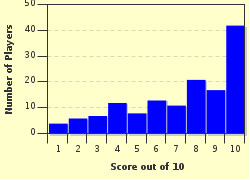Quiz Answer Key and Fun Facts
1. The first residents of the Eltham area were members of which Aboriginal group?
2. The first European settlers arrived around 1840, and a village had been established by 1851. What industry was the primary reason for settlement?
3. What transport development led to a shift northwards for the town center at the start of the 20th century?
4. Like many Australian towns, Eltham has an avenue of honour, a section of its main road planted with trees to commemorate those who died in war. In which war were the soldiers who are honoured along Main Road, Eltham fighting?
5. In 1935, Justus Jorgensen began building a home which included an art studio for himself. Expanding over the years to become an artists' colony and still in active use, what is the name of this complex?
6. Many artists were deeply influenced by the vision and lifestyle of Jorgensen, including a man who became known as 'the father of the modern mudbrick and owner- builder movements in Australia'. What was the name of this writer and architect, later mayor of Eltham?
7. Near the Eltham Library is an historic cottage which is now open to the public as a venue for light refreshments. Built in 1859 by George Stebbing and moved to its present site to make way for new council offices in 1964, this cottage is named after the family who lived there for over 80 years. What is it called?
8. In front of the Library is a statue of a famous Australian writer who lived in Eltham for part of his adult life. Best known for the autobiographical work "I Can Jump Puddles", chronicling his childhood struggles with the aftermath of polio, who is the subject of this statue?
9. Wingrove Cottage, now a medical clinic, was built in 1858 for Charles S. Wingrove, a local official. Across Main Road, and bordering Diamond Creek, is Wingrove Park, which houses a colony of one of Australia's most unusual animals. Which animal has a home in Wingrove Park?
10. The Pauline Toner Reserve is the haven for an endangered local species, whose dwindling habitats have been fiercely protected since the mid-1980s by lepidopterists and local residents. What is this endangered animal?
Source: Author
looney_tunes
This quiz was reviewed by FunTrivia editor
bloomsby before going online.
Any errors found in FunTrivia content are routinely corrected through our feedback system.

